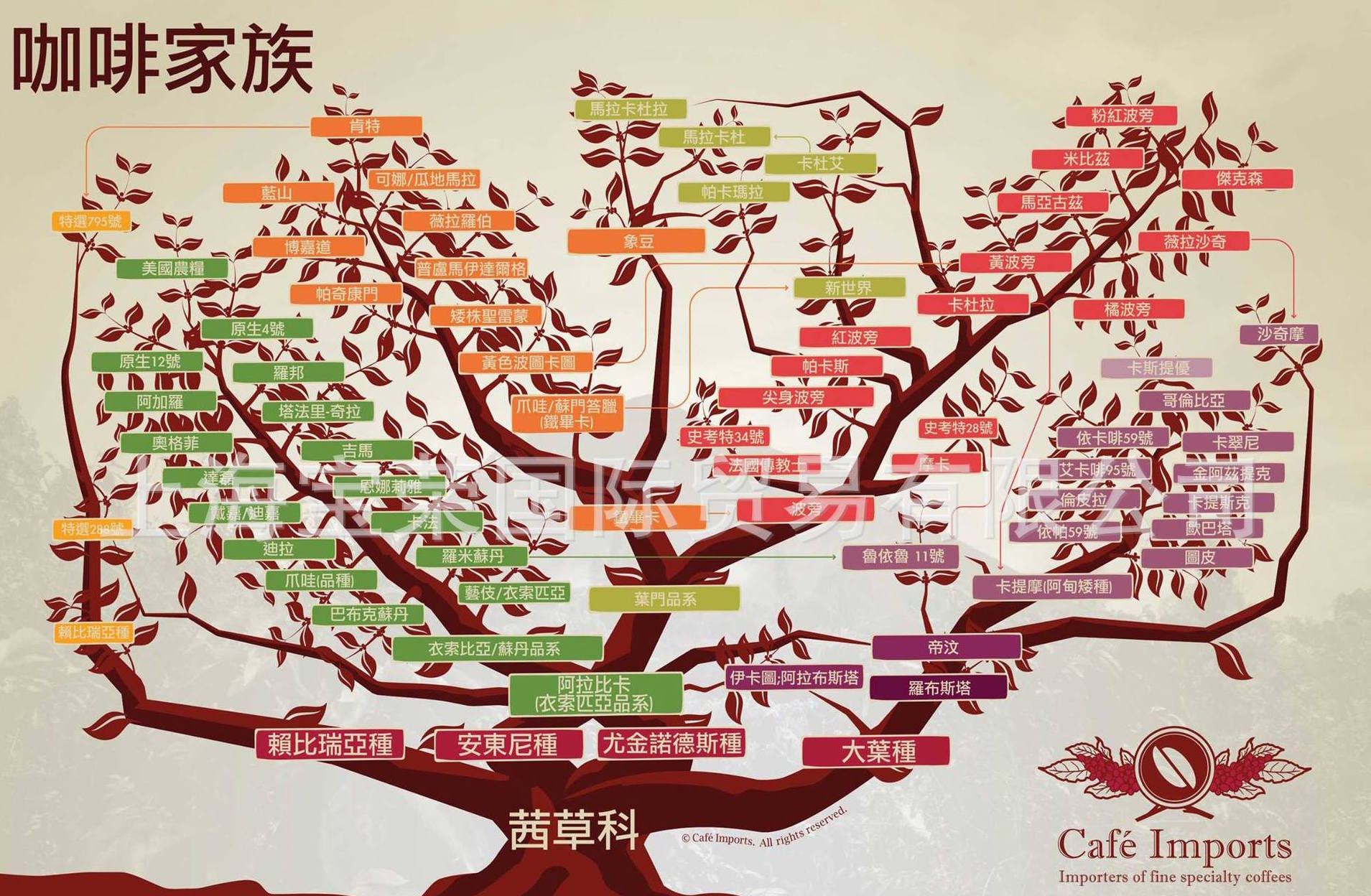Two pictures of coffee family tree in Chinese and English to learn more about coffee variety system.
Coffee variety is one of the three elements of fine coffee variety, altitude and processing, among which coffee variety is one of the most important elements. Understanding coffee family tree is a necessary knowledge to learn fine coffee.


In fact, at present, there are hundreds of coffee tree species on the earth, and nearly 100 Arabica species alone, but when it comes to fine coffee, only Arabica beans can be called fine coffee. But it is not that all Arabica species belong to fine coffee, because with the trend of variety improvement in recent years, many excellent Arabica species are growing less and less because of their low yield and resistance to diseases and insect pests. It was gradually replaced by some new and improved species. But the production of real boutique coffee depends on excellent Arabica tree species. Here are several major Arabica species.
Typica Tippica originated in the coffee region of Ethiopia more than a century ago, which is probably the oldest coffee tree species. It was brought to Central America by French naval officers in the 18th century, and later gave rise to Jamaican Blue Mountain, San Ramon, Pache, Villalobos, Java and Jember and so on. Tippica has a low yield and is not resistant to leaf rust, with long, bronzed leaves and long oval beans, with a unique flavor, especially in sweetness, purity and mellowness.
Bourbon bourbon belongs to the variety of Tippica. The name comes from the small island of Bourbon in the Indian Ocean (now known as Easter Island) and from the Bourbon dynasty in France. Although the output is 20-30% higher than that of Tipickup, it is still low. The bean shape is small and round, and the leaves are wide and turquoise. The bourbon species can be divided into red, orange and yellow fruits according to the difference of fine species. It has good acidity and a well-balanced taste.
Maragogype Malago Gippe, first found in Brazil, belongs to the variety of the Tippica family in Ethiopia. The tree number is increased, the leaves are large, and the bean grains are very large, but the yield is low. Because the beans sell well, it is favored by part of the market. Over the past century, its cultivation has been extended to Central America, and its taste varies from high mellow and rich flavor to floral and citrus flavor.
Born in Costa Rica, Villalobos is a variety of Tippica, with branches and trunks at an angle of 60 degrees and bronze leaves. It grows particularly well at high altitudes, has strong wind resistance, can grow in poor soil, and grows better under shade trees. The most striking feature of the taste is its excellent sweetness and beautiful acidity.
Villasarchi Verasaci is a bourbon hybrid improved in the Costa Rican town of sarchi. The branches have a 45-degree angle on the trunk and the leaves are bronzed. Shade tree planting and the application of a very small amount of pesticides and fertilizers make it an excellent organic coffee. Elegant acidity, delicate fruit flavor and beautiful sweetness.
Caturra Catura, from Brazil, is a high-yielding bourbon variety. The tree is taller than bourbon, the bean grain is small, the yield is high and it is resistant to leaf rust. Now its planting area is gradually expanding from Brazil to Colombia, Costa Rica and Nicaragua. Bright acidity, medium to low alcohol, but slightly inferior to bourbon in purity and sweetness.
Mundu nove Mondonovu, born in Brazil, is a hybrid of Bourbon and Sumatra. Strong environmental adaptability, resistance to diseases and insect pests, high yield. Trees up to more than three meters high should not be harvested, the taste is more balanced, the taste is close to the traditional varieties.
Catuai Carduwey is an excellent variety, which is suitable for the severe climate at high altitude and has high yield. it was first produced in Brazil and is a hybrid of caturra and mondu nove, and is now widely cultivated in Central America. However, its harvest life is relatively short, only ten years. The acidity is good, but the taste is poorer and less mellow than mundu nove.
Pacas Pacas has two theories about its origin: one is that it is just one of cattura, and the other is that it was discovered by a farmer in El Salvador named pacas. Pacas is more suitable for growth at high altitude and has high yield and strong disease resistance, which is better than bourbon species. The most important features of the taste are bright acidity and moderate mellow.
There is no complete scientific research on the Ethiopian native species of Ethiopia Heirloom, but there are about 1000 varieties derived from the Ethiopian native species, and they later spread to Yemen, India, Indonesia and South America. Among them, Tippika is one of the descendants of the original species. Ethiopian native species are very rich in flavor, with characteristics ranging from elegant floral (typical jasmine) to citrus (typical lemon), as well as chocolate and wild berries.
Important Notice :
前街咖啡 FrontStreet Coffee has moved to new addredd:
FrontStreet Coffee Address: 315,Donghua East Road,GuangZhou
Tel:020 38364473
- Prev

Can I put coffee powder in the refrigerator? how long can I keep coffee powder? how much coffee powder can I put in a cup of coffee?
Can coffee beans and coffee powder be refrigerated or frozen in the refrigerator? No! The biggest enemies of coffee beans are oxygen, moisture, light and heat. Coffee beans should be placed in an opaque and airtight ceramic container immediately after opening, and then placed in a dry and cool place. Do not use plastic or metal containers to prevent coffee beans from inhaling the smell of plastic or metal. It is recommended that you only buy within two weeks at a time.
- Next

Cappuccino Coffee Practice Cappuccino Foam Coffee Cappuccino Coffee Machine
Cappuccino coffee tastes good, but its origin is more knowledgeable, and it has always been the best body material for studying text changes in Europe and America. The history of the word Cappuccino is sufficient to show that a word often looks like something and ends up with other meanings cappuccino coffee, far beyond the original intention of the word creator. It sounds complicated. Look.
Related
- Beginners will see the "Coffee pull flower" guide!
- What is the difference between ice blog purified milk and ordinary milk coffee?
- Why is the Philippines the largest producer of crops in Liberia?
- For coffee extraction, should the fine powder be retained?
- How does extracted espresso fill pressed powder? How much strength does it take to press the powder?
- How to make jasmine cold extract coffee? Is the jasmine + latte good?
- Will this little toy really make the coffee taste better? How does Lily Drip affect coffee extraction?
- Will the action of slapping the filter cup also affect coffee extraction?
- What's the difference between powder-to-water ratio and powder-to-liquid ratio?
- What is the Ethiopian local species? What does it have to do with Heirloom native species?

